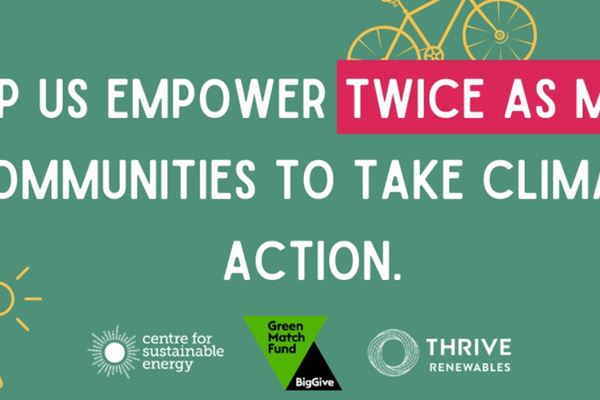We have today published our annual results for 2022, reporting an operating profit of £6.7 million and a turnover of £17.5 million. £11.4 million has been allocated to developing new onshore wind, solar, hydro, battery storage, and geothermal projects which will generate more clean energy and help reduce consumer bills. Thrive’s assets under management now total £110 million.
In what was a record-breaking year for wind power in the UK, we saw strong operational performance across our portfolio – generating 133,858 MWh of clean electricity, enough to power 38,000 homes, the equivalent to a town the size of Halifax.[3] Our clean energy projects also delivered 58,314 tonnes in carbon emissions reductions. [5]
Shareholders received a dividend of 7 pence per share in 2022*. Reflecting positive financial results, a 12 pence per share annual dividend is recommended to be paid in July 2023.
2022 showed us once again that we need to accelerate the UK’s transition to a renewables-based energy system, not only to tackle the climate emergency but to reduce soaring energy bills and end the UK’s reliance on expensive fossil fuels. In total, Thrive installed 6MW of new clean energy capacity during the year with a further 25MW in construction.
Over the past 12 months, we’re proud to have succeeded in our mission to connect more people with clean energy, welcoming over 900 new shareholders to the Thrive community as part of a successful crowdfund with Triodos Bank. A total of £6.8 million was raised which, alongside the additional profits generated from our existing portfolio, is being used to fund new clean energy projects.


In terms of delivering our mission, another one of our 2022 highlights was funding the construction of England’s largest onshore wind turbine, a community-owned project in our home city of Bristol. The turbine will generate a new revenue stream for the local community in Lawrence Weston, with all profits from electricity sales reinvested locally, acting as a driver for regeneration in a deprived area.
“2022 has been a challenging year for many, with energy bills soaring as a result of the UK’s dependence on gas. Our response is to continue getting new renewable capacity built. This includes community-based projects such as England’s largest onshore wind turbine, as well as funding new rooftop solar arrays that help UK businesses to decarbonise and constructing a 20 MW battery storage project that will offer vital flexibility services to the grid. We've allocated a total of £11.4 million to developing more projects - all of which will help with decarbonising the UK’s electricity system so that people can benefit from cheaper, cleaner power in future.” – Matthew Clayton, Managing Director, Thrive Renewables
In 2023, we expect to see new ‘direct wire’ on-site commercial solar rooftop arrays installed, construction of the ground-breaking United Downs geothermal electricity generating project in Cornwall and our second battery storage site – a 20MW project in Bristol will be fully operational. There are also a number of new investments which are currently in the pipeline.
“At a critical time for the climate emergency, the success of Thrive’s fundraise has proven yet again that there is huge support for renewables in the UK – we now unite a community of over 7,000 investors. Following a successful 2022, the team are focusing on action – investing in projects that will help to accelerate our transition to net zero, while ensuring renewables benefit the whole of society.” – Jo Butlin, Chair, Thrive Renewables

As a certified B Corporation, we were recognised as a ‘Best for the World’ B Corp for the second year running, scoring in the top 5% globally for our positive impact on the environment. Thrive’s commitment to building a cleaner, more sustainable world also saw us publish our net zero strategy in 2022, committing to achieving net zero emissions by 2030, as well as our biodiversity policy which outlines our plans to protect and enhance nature close to our clean energy sites.
We are also pleased that our voluntary Community Benefit Programme, which provides grants for energy efficiency improvements in community centres and village halls close to our sites, helped provide warm spaces for vulnerable people last winter. Working with the Centre for Sustainable Energy, we provided over £30,000 worth of funding to ten community buildings in 2022. This included awarding £4,000 to Eastside Community Trust, who run the Easton Community Centre in Bristol, so that it could install essential pipe and loft insulation. Addressing heat loss in the building as well as high energy bills, the improvements have helped the team reduce their operational costs and create a warmer, cosier and more inviting space for residents to enjoy.
Fuel poverty is a massive issue so we were also pleased to be given the opportunity to support the Centre for Sustainable Energy’s Warm Homes campaign, which will help them continue providing essential advice and support for those who are struggling.


* Please remember that past performance cannot be relied on as a guide to future returns
[1] Impact Portfolio describing Thrive’s share of projects owned plus the projects Thrive is funding.
[2] Calculated using the most recent statistics from the Department of Business, Energy and Industrial Strategy (BEIS) showing that UK average domestic household consumption is 3,509 kWh per annum https://www.renewableuk.com/page/UKWEDExplained
[3] Average residents per household 2.4 (https://www.ons.gov.uk/peoplepopulationandcommunity/birthsdeathsandmarriages/families/bulletins/familiesandhouseholds/2020), Population of Halifax is 91,338 (https://www.thegeographist.com/uk-cities-population-1000/)
[4] The average electricity consumption of an electric vehicle is 270Wh/mile (https://ev-database.uk/cheatsheet/energy-consumption-electric-car) and vehicle licensing statistics: 2021 - (https://www.gov.uk/government/statistics/vehicle-licensing-statistics-2021/vehicle-licensing-statistics-2021#licensed-electric-vehicles), average annual car mileage is 5,300 miles (https://www.gov.uk/government/statistical-data-sets/nts09-vehicle-mileage-and-occupancy#car-mileage), reported UK electric car fleet as of May 2022 is 421,230 (https://www.gov.uk/government/statistics/vehicle-licensing-statistics-2021/vehicle-licensing-statistics-2021#licensed-electric-vehicles), and average annual mileage of 93,562 Electric Vehicles, (22.2% of the UK’s Electric Car Fleet)
[5] RenewableUK uses BEIS’s “all non-renewable fuels” emissions statistic of 432 tonnes of carbon dioxide per GWh of electricity supplied in the Digest of UK Energy Statistics (July 2022) Table 5.14 (“Estimated carbon dioxide emissions from electricity supplied”). Carbon reduction calculated by multiplying the total amount of renewable electricity generated by Thrive’s impact portfolio per year by the number of tonnes of carbon which fossil fuels would have produced to generate the same amount of electricity.
[6] We are not able to source a nationally recognised means of calculating the water saving generated by generating electricity using wind and solar. The power sector consumes over 40% of Europe’s water, mainly for cooling purposes. Nuclear consumes approximately 2.7m3/MWh, gas plants 0.7m3/MWh and coal plants 1.9m3/MWh (https://www.ewea.org/fileadmin/files/library/publications/ reports/Saving_water_with_wind_energy.pdf). Our crude, but intentionally conservative analysis, using the UKs 2021 generation mix (https://assets.publishing.service.gov.uk/government/uploads/system/uploads/attachment_data/file/1064800/Energy_Trends_March_2022.pdf), provides a conservative average water consumption per MWh figure which attributes no water consumption to other thermal sources such as oil and bioenergy, or hydro. We have multiplied Thrive’s generation by this factor, assuming that if our renewable projects had not generated this electricity, the UK grid mix would have.
[7] Includes Community Benefit Programme donations, CSE winter campaign donation, a number of individual site related donations and our community open day hosted at Avonmouth wind farm.



